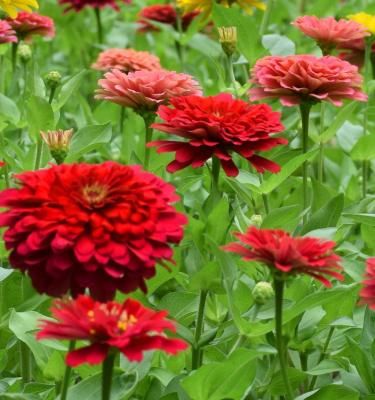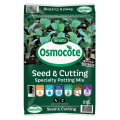

How to grow & care for Zinnia
Zinnias are colourful and cheerful summer flowering annual plants that are a must for all gardens during the warmer months. Their flowers come in a huge range of colours from pale pastels to bold brights and everything in between. You’ll also find single zinnias with a flat, open flower and double zinnias with almost round, pom pom like blooms. Zinnias also come in a range of sizes from petite, short growing varieties that reach 15-20cm tall when fully grown to tall towering ones that can be closer to a metre tall.
Whichever zinnias you choose to grow in your garden - the bees, butterflies and beneficial insects will thank you!
Top 5 steps to growing zinnias
- Choose a full sun spot in a compost enriched soil or grow in pots or hanging baskets.
- Zinnias should be planted after your last frost or in spring/summer when the days are warm.
- Cut off spent flower heads to encourage more blooms to follow and encourage a bushy plant.
- Fertilise with Scotts Osmocote All Purpose Controlled Release Fertiliser at planting and fortnightly with Scotts Osmocote Pour+Feed for Flowering Plants for even more flowers.
- Zinnias are the perfect summer flowering plant to encourage beneficial insects and bees into your garden - plant them amongst vegetables and fruiting plants or in decorative pots.
Shopping List
- Zinnia seedlings, potted plants or seeds
- Scotts Osmocote All Purpose Controlled Release Fertiliser
- Scotts Osmocote Pour+Feed for Flowering Plants
- Scotts Osmocote Compost Premium Soil Improver
- Garden trowel
- Mulch
- Defender Pyrethrum Insect Spray
- Defender Snail & Slug Pellets
- If growing in pots, you’ll need Scotts Osmocote Premium Potting Mix + Scotts Osmocote Pour+Feed for Flowering Plants and a suitable pot or container
Preparation & Planting in the garden
Zinnias prefer a full sun spot in a moist, but free draining soil and they’ll perform best with regular water during hot weather. If you live in a climate with extremely hot summers, they’ll benefit from a little afternoon sun protection.
Prepare the site for planting by mixing a little Scotts Osmocote Compost Premium Soil Improver through the original soil - using a garden shovel to turn it through the top 10cm.
Gently remove the zinnia seedling or plant from the nursery punnet or pot and tease the roots lightly if they are compact.
Plant your zinnias into the prepared soil and backfill around each. Always follow the labels directions for spacing zinnia plants or seedlings as some spread out more than others.
To encourage bushy plants pinch out the growing top from your zinnia seedlings when they are 15-20cm tall. This promotes plenty of side shoots and more flowers.
Water in well and mulch to suppress weeds and retain moisture.
Growing from seed
Zinnias have tiny seeds which are best sown in punnets or small pots filled with Scotts Osmocote Seed & Cutting Premium Potting Mix. Sprinkle the zinnia seeds sparingly on the surface of the seed raising mix and lightly cover them with more seed raising mix. Mist them to keep them moist while they germinate in 10-14 days.
Once the seedlings have 2 sets of true leaves they can be transplanted in your garden or larger pots.
Planting in pots
Zinnias can be grown in any size pot with good drainage - choose a pot to suit the mature height and width of your chosen zinnia variety. If you’re limited on space look for the shorter growing zinnias that do well in small pots.
Fill your pot or planter with Scotts Osmocote Premium Potting Mix. Gently remove the zinnia from the nursery pot and tease the roots lightly if they are compact or seperate the plants if they are growing in punnets. Plant the zinnias into the potting mix and backfill around each plant. Water in well and top the soil with mulch to retain moisture.
Fertilising & Care
Zinnias will benefit from a single application of Scotts Osmocote All Purpose Controlled Release Fertiliser at planting plus some extra food for maximum flowering. Apply Scotts Osmocote Pour+Feed for Flowering Plants fortnightly during the growing season.
Deadhead zinnias throughout the flowering season to encourage bushy plants and more flowers. Zinnias make wonderful cut flowers for indoor floral arrangements - so be sure to cut a few to bring inside and enjoy.
Taller growing zinnias may need support in the form of garden stakes with string or large square netting strung horizontally between them to prevent the plants from falling over.
Pests & Diseases
Slugs and Snails can cause significant damage to young zinnia seedlings. Protect young plants by setting beer traps (saucers filled with beer) amongst seedlings or use Defender Snail & Slug Pellets.
Caterpillars can from time to time infest zinnia plants - they’ll eat the leaves and flowers. Remove and squash caterpillars as you find them or if needed use a spray like Defender Pyrethrum Insect Spray to control them.
To reduce the risk of powdery mildew fungal outbreak on the leaves of your zinnia plants, avoid overhead watering and make sure your plants have good airflow between them.



